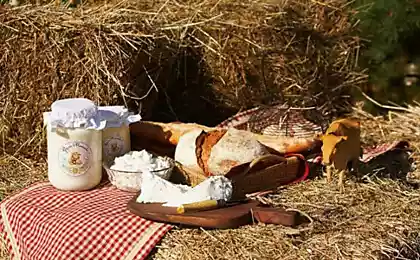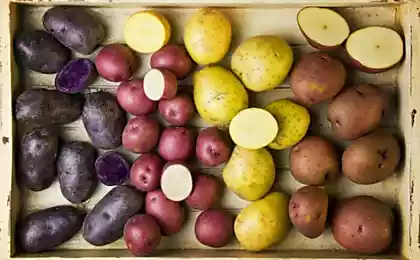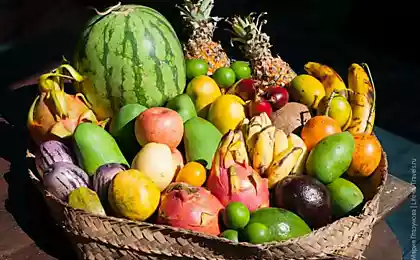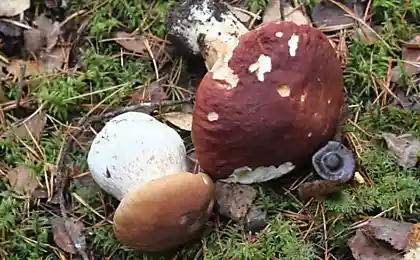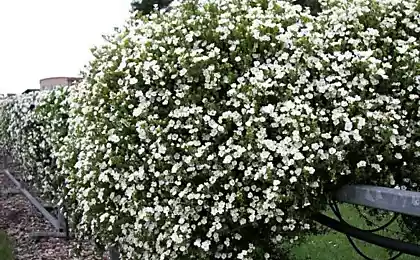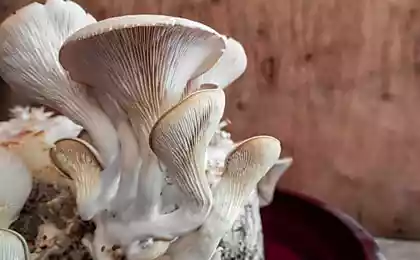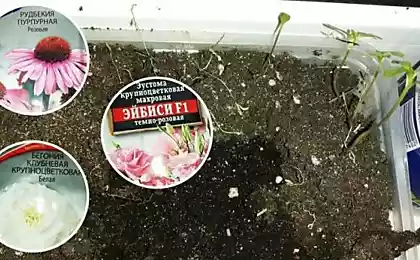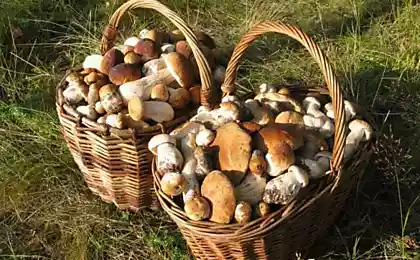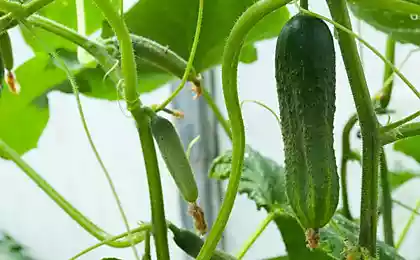628
Pineapple: what are and how to grow a house from a tuft
Fourteen million four hundred sixty seven thousand one hundred eighty
Pineapple is a fairly common tropical fruit, looks like its fruit and what it tastes like they know everything. However, growing pineapple for many remains unknown. Find out what this unusual plant from the point of view of botany.
Pineapple is a tropical perennial, is a herbaceous plant. In adulthood and in the open ground pineapple can reach 1.5 meters in height, depending on variety. The plant has a low, down-to-earth stem with stiff leaves and is more like a shrub than a grass.
In the first year after pasadenans actively growing, its trunk thickens and acquires dozens of intertwined leaves. The leaves of the pineapple grow narrow, fleshy, sharp spikes at the edges, reach a length of 70 cm Pineapple easy going through dry periods, due to its leaves that can accumulate and store large quantities of liquid.
After about 12 months of active growth, the pineapple releases from the top of the spike-like inflorescence with many flowers. The pineapple flowers are usually bisexual, and their color varies from purple, to red, depending on varieties of the plant. From each flower develops a berry. Berries pineapple grow and get filled with juice, bound up and forming together the fruit that we used to see in stores.
If there is a pollination of a flower of pineapple, berries, a small seed. The presence of seeds in the fruit of the pineapple has a negative impact on their edibility, and of course cost. People involved in commercial cultivation of pineapples, are trying to get rid of pollinating plants.
After maturation of the first fruits of pineapple produces side shoots from the axils of the leaves. In the cultivation of pineapples these shoots often are used for vegetative propagation. After removal of side-shoots the main plant after some time again will bloom and bear fruit. After gathering the second harvest the pineapples have been uprooted and in their place planted a new one.
In addition to these side shoots, in ornamental cultivation of pineapples often use their seeds, or the top of the fruit. The top of the Mature fruit of pineapple is a kind of crown from the rudiments of leaves, and in fact is a young pineapple is ready, under certain conditions, grow into a new plant.
In addition to the cultivated people who naturally grow wild pineapples, they are the fruits of smaller size and filled with many seeds. These pineapples are a favorite food for some wildlife.
Where they grow pineapples. Homeland of pineapplePineapple is the second leading fruit consumption in the world, accounting for about 20% of the world production of tropical fruits. About 70% of all traditionally grown pineapples are consumed fresh in the countries where they grow pineapples. Homeland of pineapple I think Brazil and Paraguay, where these fruits were cultivated.Brazil, Thailand, the Philippines, China are the main pineapple producers in the world, growing more than half of the total production. Other major producers are called India, Nigeria, Kenya, Indonesia, Mexico and Costa Rica. These countries provide world production the second half of the pineapples.
Since 1960, the volume of pineapple cultivation worldwide increased by about 5 times. The growing popularity of the fruit associated with the breeding of the "Golden" variety, obtained and patented by Fresh Del Monte in the 1990-ies. World trade volumes of canned pineapples has almost doubled in the last 15 years.
Currently, one of the two grown pineapple goes on sale. With the increase in consumer demand for fresh pineapple and pineapple juice, exports of pineapples has become a complex chain involving large and small companies. Historically, the world's largest manufacturer and supplier of pineapple are Hawaii that supply these fruits to the US market. The pineapple variety that has gained immense popularity in recent times — Del Monte Gold, was bred in research Institute in Hawaii in 1970. However, in recent years, industrial production of canned pineapple in Hawaii has been suspended due to filling of the market with cheaper pineapples from other manufacturers. In Hawaii, you can still find the pineapple plantations that export fresh fruit to Japan and the US West.
Twelve countries provide 90% of the world's demand for fresh pineapples is: USA, France, Japan, Belgium, Italy, Germany, Canada, Spain, England, Korea, Netherlands and Singapore. Our country is among them unfortunately not.
Dole Food Company, Inc is world's second largest manufacturer and supplier of fresh pineapples and the world's largest manufacturer and supplier of other fresh fruit. Dole is also present on the world market of fresh vegetables, flowers and prepared foods. In 2004, Dole belonged to more than 150,000 hectares of land around the world. In 2007 the net income of the Dole amounted to $ 89 million Dole sells over 200 products and operates in more than 90 countries, the company has about 45,000 employees. Dole is the property of a private company owned by David Murdock, who is one of the richest men in the world.
Dole is vertically integrated, so it controls all stages of the process: production, packaging, export, shipping, import and ripening of fresh fruits and vegetables. In 2004, Dole sold over 25 million boxes of pineapple worldwide. Fresh pineapples were eight percent of the revenues of the company in 2007.
The farms where the Dole pineapples are grown, is located on leased land, and independent farms in Latin America (mainly Costa Rica), Philippines, Thailand, and other places. Dole owns about 6,600 acres of land in Honduras, 7,300 acres of land in Costa Rica and 3,000 acres of land in Ecuador, all related to pineapple production, including for export to Russia.
What are the pineapples. Species and varieties of pineapples.In international fruit trade numerous varieties of pineapple are grouped into four main classes: "Smooth Cayenne", "Red Spanish", "Royal" and "Abacaxi", although there are many differences within subgroups.Smooth Cayenne (To include the varieties: "Mayuri", "q", "Sarawak", "Esmeralda", "Claire", "Typhoon", "Saint-Michel") — pineapple this variety is widely cultivated in Hawaii, the Philippines, Australia, South Africa, Puerto Rico, Kenya, Mexico, Cuba and Formosa. Pineapples are of the variety "Smooth Cayenne" egg-shaped medium in size, reaching 1.5 to 2.5 kg, the fruits is based on a short and strong peduncle. They ripen gradually, turn yellow from the base to the top. The yellow top of the pineapple means the full maturity of the fruit. The pulp of the fruit of such varieties is dense, with big texture, juicy with yellow color at the end of ripening. The medium range of acid content in varieties of "Smooth Cayenne" is between 0.5 and 1.0%, and the total soluble solids content (TSS) between 12 ° and 16 ° Brix. Pineapple plants of these species produce few shoots and shoots. The cycle of growth and ripening of these pineapples are much longer.
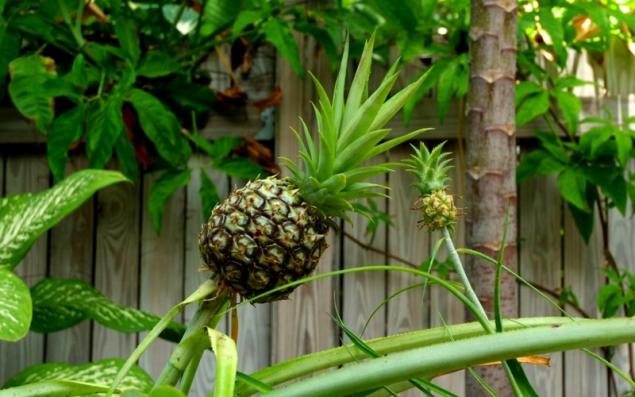
Mauritius (Mauritius)is used for commercial cultivation, resistant to long-distance traffic. The fruits of this variety have good taste, transportable. The Vazhakulam pineapple, this species, also known as, Cannara, belongs to a group of Royal varieties. The fruit of this variety reaches the average weight of the fetus in the 1300-1600 grams. The fruits of Cannara is endowed with a pleasant aroma, have a slightly conical shape, fruit eyes deeply set, the flesh has a distinct Golden-yellow color, acidity is 0.50 — 0.70 percent. Is a good source of carotene, vitamins and minerals.
Amritha hybrid between Ripley and Kew. The pineapple plant of this variety has spiky leaves, the period from planting to ripening of the fruit is 13-15 months. The fruits of nectar, cylindrical, slightly tapering upward, reach a weight of 1.5-2.0 kg. the Crown of the pineapple is rather small 80-100g. Fruits uniformly yellow when ripe; deepening near the eyes are missing, which makes it easy to clean. The fruits of varieties with a mild and pleasant aroma, the thickness of the skin is not more than 6 mm. the Flesh of a hybrid dense, not fibrous, pale yellow color with a rich aroma, has a good taste with low acidity.
MD-2 is a hybrid pineapple derived by the breeding programme of pineapple research Institute in Hawaii, the program ceased to exist. Derived variety has taken root and spread widely in the world. The fruit of this variety is bright Golden, very sweet, low-acidity flesh, plants showed high resistance to parasites and internal rot. The fruit of MD-2's ability to preserve the freshness during cold storage for up to two weeks.
MD-2 is the benchmark for international market fruit because of its color, taste, shape, storage time and ripeness. Industrial cultivation of MD-2 in different variations were launched in Central and South America in 1996. But currently this variety occupies 50-55% of the market worldwide and 70-75% of the European market for fresh pineapple. This is due to its excellent consumer properties: high value of Brix number (17 for ripe fruit), low acidity (0,4-0,45%), the average size of fruits (from 1.5 to 2.0 kg), the right cylindrical shape, small core, resistance to internal darkening of the pulp, long shelf life (about 30 days).
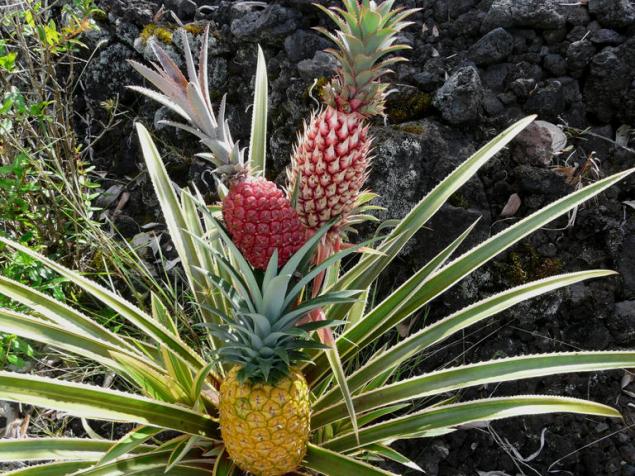
The most important qualities of the MD-2 is its long shelf life and a cylindrical shape, which is crucial for marketing purposes. Instead of the standard period of 21 days for other varieties MD-2 has a 30 day shelf life and are able to additionally remain in the cold for two weeks. This kind of usually import from Costa Rica, Ghana, Cuba.
Ornamental pineapples (Ananas Nanas) is very popular among landscape designers and landscapers. They have very beautiful flowers and reddish leaves.
How to grow a pineapple at homePineapples are one of the most unusual tropical fruits in the world. Pineapple may be grown in the temperate zone under controlled conditions or in the apartment. This files most often for growing in decorative purposes as planting material is the crown of the fruit of the pineapple, in this case, the most difficult stage of cultivation is to obtain the roots. But it is worth noting that it is possible to plant from seed, the pineapple, the problem here is in the selection of seed.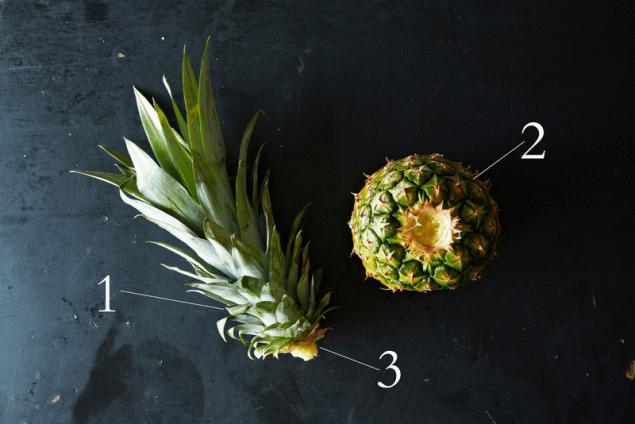
Showing a degree of patience and care, it is even possible to grow a pineapple at home on the windowsill. Of course a full-size plants and lots of fruit to fail, but overseas visitor will undoubtedly be Your favorite house plant.
The pineapple belongs to the bromeliad family and is related by ties of kinship with some decorative plants sold in nurseries. Plants of this family is interesting because accumulate water (dew) and nutrients in places of fastening of leaves to the trunk, forming reservoirs. And from there through the hairs moisture is absorbed by the plant; thus, bromeliads have adapted to survive in dry periods. The pineapple, however, as the primary means of food uses the roots.
The cultivation of pineapple from the crest.
First you need to buy a ripe pineapple. Crest suitable for planting the pineapple should have a healthy, strong, green live leaves, and the rind should be Golden brown. The presence of gray spots on the base of the leaves indicates the presence of mealybugs, such pineapple for planting it is better not to use. For a greater probability select two pineapples, in case of death of one of them, the experiment can be continued with another, or to choose a stronger instance.
Then you need to prepare the crown of the pineapple for planting. Clasp your hand all the sheets and gently rotate. The crest must be separated from the fruit with a small stem at the bottom. To do this, you can also use a knife, cut off the top part of the pineapple, but the remaining flesh should be separated from the crown, so that no further decay occurred. Remove a few lower leaves so that a few inches to expose the base of the stem of a pineapple, he then must take root. After trimming and cleaning, leave the pineapple for a few days to cut and the scars from the leaves dry and not rotted.
To obtain the roots use the easiest and, as practice shows, the most effective method: place the dried crown in a glass of water so that water covered the naked gun. A glass of pineapple place it on the windowsill next to Your plants. Follow the water level periodically and replace the water completely, after about three weeks, the pineapple needs to put down roots. When the roots reach a couple of inches in length, then the pineapple can be planted in the ground.
As a substrate for rooting it can be mixed in equal parts soil for houseplants, peat and river sand. For the primary landing, take a small pot with a diameter approximately equal to the size of the tuft. Arrange for good drainage of expanded clay, frequent watering to avoid water stagnation and rotting of the soil. Young pineapple likes to the soil was kept moist but not flooded. Also, it should not be located under direct sunlight, but the place should be lit.
Rooting the home of the pineapple will take from six to eight weeks. A good sign will be the appearance of new leaves, so the plant has taken root, struck deep roots and ready to grow further. In the absence of signs of life pineapple after two months, you can think about re-planting new plants.
In the future, the original leaves of the pineapple tuft will brown and wither away, they must be grown greens. As the withering away of the old leaves, they must be carefully trimmed. Grown pineapple should be watered no more than once a week.
After approximately one year of growth pineapple room needs to be transplanted to a larger pot with added soil mixture, same composition as the soil for cacti. Pineapple does not tolerate stagnation of water, therefore, good drainage gravel and expanded clay — is a prerequisite for successful cultivation of pineapple at home. During the winter months the growth of pineapple is terminated after a period of rest, the spring development must continue. If not, probably the pineapple already depleted the soil and required following transplantation with the replacement of the old soil.
The care of home pineapple. The light and temperature.
Pineapple is a tropical plant and the cold and frost will kill it. If You live in a temperate climate, Your pineapple room can be placed on the balcony or stand in the garden, in a moderately lighted place. Being on the fresh air stimulates its growth. Pineapple needs at least 6 hours a day to be on a well-lit area, regardless of the time of year.
In the colder months keep the plant indoors, without drafts and away from heaters. In the winter put a pineapple tree on the South side for maximum sunlight. The optimum temperature for pineapple is 22-26 degrees Celsius, if You are comfortable, then feels good and the pineapple room.
Watering and fertilizing pineapple in a pot.Ripe pineapple does not need to be watered as often and not badly adapted to drought. In the cultivation of pineapple is enough to water the plant once a week. While plants outdoors, you can sometimes spray the leaves with water and then the liquid will soak the pineapple from the base of the leaves, and the excess to evaporate quickly under the influence of wind. The soil in the pot should not dry completely, but on the other hand the water should not linger, and the maximum flow through the drainage. In the period of active growth of the pineapple room need to be watered more often than in winter. In the case of overflow and decay of the soil (mold, swampy smell) the soil needs to be completely replaced or the plant may die.
Fertilize the pineapple gently, about once a month and only during the vegetation period. Possible feeding with liquid fertilizer through spraying the leaves, but in this case, keep the nutrient solution from falling on the young leaves, otherwise they may be damaged.
Pests and diseases.
Pineapple room will be subject to minimal exposure to pests with the proper care. However, even with the house may attack pineapple mealybug and various mites. These pests can be removed by washing plants with soapy water and then rinsing with clean water. It is possible to use insecticides, be sure to follow the instructions of the drug.
Another disease which may be affected by Your pineapple is rot of heartwood caused by the fungus. The Central leaves of a diseased plant become black, and is easily pulled out from the trunk. With the defeat of the fungus pineapple you can save by pouring a fungicide into the heart of the plant. If the tool will destroy the infection, the plant will produce a side shoot; old trunk eventually can be cut.
Flowering and fruiting pineapple at home.
In natural conditions the pineapple takes up to 26 months to produce a new fruit. When growing pineapple at home, the timing of flowering can vary in any direction. Usually after about 16 months, when the pineapple reaches a height of not less than 25 cm in height, you can count on the appearance of the inflorescence. Bud begins to form on the top of the plant, gradually moving away from it on growing up the stalk, which is a continuation of the trunk. Within two months to begin flowering, continuing for two weeks. Bright blue flowers off row by row. Each flower opens for just one day.
After drying the last of the flower begins to develop fruit. The period of development and maturation is 3 to six months depending on the conditions and varieties of pineapple.
Forced fruiting indoor pineapple.
Often when growing pineapple in pot flowering is delayed or not happen at all. If the pineapple has developed enough and reached the desired age, it is possible to stimulate the flowering. Stimulant forced fruiting of bromeliads is ethylene. To obtain pour a teaspoon of calcium carbide in half a liter of water a day will keep the solution in a closed jar. Then pour the liquid into another container, freeing it from the sediment. The water is an aqueous solution of ethylene. Times a day during the week, pour 50 grams of solution in the base of the upper leaves of the pineapple.
After this procedure, flowering should begin within 4-6 weeks. If not, then Your pineapple room is not yet ready for fruiting or sick.
After fruiting, pineapple, as well as any herbaceous plant will die, but it will happen gradually with the deflation of many lateral shoots, which are usually used for cultivation of pineapple on a commercial scale. published
Source: proavokado.ru/ananas/kak-rastet-ananas.shtml
Pineapple is a fairly common tropical fruit, looks like its fruit and what it tastes like they know everything. However, growing pineapple for many remains unknown. Find out what this unusual plant from the point of view of botany.
Pineapple is a tropical perennial, is a herbaceous plant. In adulthood and in the open ground pineapple can reach 1.5 meters in height, depending on variety. The plant has a low, down-to-earth stem with stiff leaves and is more like a shrub than a grass.
In the first year after pasadenans actively growing, its trunk thickens and acquires dozens of intertwined leaves. The leaves of the pineapple grow narrow, fleshy, sharp spikes at the edges, reach a length of 70 cm Pineapple easy going through dry periods, due to its leaves that can accumulate and store large quantities of liquid.
After about 12 months of active growth, the pineapple releases from the top of the spike-like inflorescence with many flowers. The pineapple flowers are usually bisexual, and their color varies from purple, to red, depending on varieties of the plant. From each flower develops a berry. Berries pineapple grow and get filled with juice, bound up and forming together the fruit that we used to see in stores.
If there is a pollination of a flower of pineapple, berries, a small seed. The presence of seeds in the fruit of the pineapple has a negative impact on their edibility, and of course cost. People involved in commercial cultivation of pineapples, are trying to get rid of pollinating plants.
After maturation of the first fruits of pineapple produces side shoots from the axils of the leaves. In the cultivation of pineapples these shoots often are used for vegetative propagation. After removal of side-shoots the main plant after some time again will bloom and bear fruit. After gathering the second harvest the pineapples have been uprooted and in their place planted a new one.
In addition to these side shoots, in ornamental cultivation of pineapples often use their seeds, or the top of the fruit. The top of the Mature fruit of pineapple is a kind of crown from the rudiments of leaves, and in fact is a young pineapple is ready, under certain conditions, grow into a new plant.
In addition to the cultivated people who naturally grow wild pineapples, they are the fruits of smaller size and filled with many seeds. These pineapples are a favorite food for some wildlife.
Where they grow pineapples. Homeland of pineapplePineapple is the second leading fruit consumption in the world, accounting for about 20% of the world production of tropical fruits. About 70% of all traditionally grown pineapples are consumed fresh in the countries where they grow pineapples. Homeland of pineapple I think Brazil and Paraguay, where these fruits were cultivated.Brazil, Thailand, the Philippines, China are the main pineapple producers in the world, growing more than half of the total production. Other major producers are called India, Nigeria, Kenya, Indonesia, Mexico and Costa Rica. These countries provide world production the second half of the pineapples.
Since 1960, the volume of pineapple cultivation worldwide increased by about 5 times. The growing popularity of the fruit associated with the breeding of the "Golden" variety, obtained and patented by Fresh Del Monte in the 1990-ies. World trade volumes of canned pineapples has almost doubled in the last 15 years.
Currently, one of the two grown pineapple goes on sale. With the increase in consumer demand for fresh pineapple and pineapple juice, exports of pineapples has become a complex chain involving large and small companies. Historically, the world's largest manufacturer and supplier of pineapple are Hawaii that supply these fruits to the US market. The pineapple variety that has gained immense popularity in recent times — Del Monte Gold, was bred in research Institute in Hawaii in 1970. However, in recent years, industrial production of canned pineapple in Hawaii has been suspended due to filling of the market with cheaper pineapples from other manufacturers. In Hawaii, you can still find the pineapple plantations that export fresh fruit to Japan and the US West.
Twelve countries provide 90% of the world's demand for fresh pineapples is: USA, France, Japan, Belgium, Italy, Germany, Canada, Spain, England, Korea, Netherlands and Singapore. Our country is among them unfortunately not.
Dole Food Company, Inc is world's second largest manufacturer and supplier of fresh pineapples and the world's largest manufacturer and supplier of other fresh fruit. Dole is also present on the world market of fresh vegetables, flowers and prepared foods. In 2004, Dole belonged to more than 150,000 hectares of land around the world. In 2007 the net income of the Dole amounted to $ 89 million Dole sells over 200 products and operates in more than 90 countries, the company has about 45,000 employees. Dole is the property of a private company owned by David Murdock, who is one of the richest men in the world.
Dole is vertically integrated, so it controls all stages of the process: production, packaging, export, shipping, import and ripening of fresh fruits and vegetables. In 2004, Dole sold over 25 million boxes of pineapple worldwide. Fresh pineapples were eight percent of the revenues of the company in 2007.
The farms where the Dole pineapples are grown, is located on leased land, and independent farms in Latin America (mainly Costa Rica), Philippines, Thailand, and other places. Dole owns about 6,600 acres of land in Honduras, 7,300 acres of land in Costa Rica and 3,000 acres of land in Ecuador, all related to pineapple production, including for export to Russia.
What are the pineapples. Species and varieties of pineapples.In international fruit trade numerous varieties of pineapple are grouped into four main classes: "Smooth Cayenne", "Red Spanish", "Royal" and "Abacaxi", although there are many differences within subgroups.Smooth Cayenne (To include the varieties: "Mayuri", "q", "Sarawak", "Esmeralda", "Claire", "Typhoon", "Saint-Michel") — pineapple this variety is widely cultivated in Hawaii, the Philippines, Australia, South Africa, Puerto Rico, Kenya, Mexico, Cuba and Formosa. Pineapples are of the variety "Smooth Cayenne" egg-shaped medium in size, reaching 1.5 to 2.5 kg, the fruits is based on a short and strong peduncle. They ripen gradually, turn yellow from the base to the top. The yellow top of the pineapple means the full maturity of the fruit. The pulp of the fruit of such varieties is dense, with big texture, juicy with yellow color at the end of ripening. The medium range of acid content in varieties of "Smooth Cayenne" is between 0.5 and 1.0%, and the total soluble solids content (TSS) between 12 ° and 16 ° Brix. Pineapple plants of these species produce few shoots and shoots. The cycle of growth and ripening of these pineapples are much longer.

Mauritius (Mauritius)is used for commercial cultivation, resistant to long-distance traffic. The fruits of this variety have good taste, transportable. The Vazhakulam pineapple, this species, also known as, Cannara, belongs to a group of Royal varieties. The fruit of this variety reaches the average weight of the fetus in the 1300-1600 grams. The fruits of Cannara is endowed with a pleasant aroma, have a slightly conical shape, fruit eyes deeply set, the flesh has a distinct Golden-yellow color, acidity is 0.50 — 0.70 percent. Is a good source of carotene, vitamins and minerals.
Amritha hybrid between Ripley and Kew. The pineapple plant of this variety has spiky leaves, the period from planting to ripening of the fruit is 13-15 months. The fruits of nectar, cylindrical, slightly tapering upward, reach a weight of 1.5-2.0 kg. the Crown of the pineapple is rather small 80-100g. Fruits uniformly yellow when ripe; deepening near the eyes are missing, which makes it easy to clean. The fruits of varieties with a mild and pleasant aroma, the thickness of the skin is not more than 6 mm. the Flesh of a hybrid dense, not fibrous, pale yellow color with a rich aroma, has a good taste with low acidity.
MD-2 is a hybrid pineapple derived by the breeding programme of pineapple research Institute in Hawaii, the program ceased to exist. Derived variety has taken root and spread widely in the world. The fruit of this variety is bright Golden, very sweet, low-acidity flesh, plants showed high resistance to parasites and internal rot. The fruit of MD-2's ability to preserve the freshness during cold storage for up to two weeks.
MD-2 is the benchmark for international market fruit because of its color, taste, shape, storage time and ripeness. Industrial cultivation of MD-2 in different variations were launched in Central and South America in 1996. But currently this variety occupies 50-55% of the market worldwide and 70-75% of the European market for fresh pineapple. This is due to its excellent consumer properties: high value of Brix number (17 for ripe fruit), low acidity (0,4-0,45%), the average size of fruits (from 1.5 to 2.0 kg), the right cylindrical shape, small core, resistance to internal darkening of the pulp, long shelf life (about 30 days).

The most important qualities of the MD-2 is its long shelf life and a cylindrical shape, which is crucial for marketing purposes. Instead of the standard period of 21 days for other varieties MD-2 has a 30 day shelf life and are able to additionally remain in the cold for two weeks. This kind of usually import from Costa Rica, Ghana, Cuba.
Ornamental pineapples (Ananas Nanas) is very popular among landscape designers and landscapers. They have very beautiful flowers and reddish leaves.
How to grow a pineapple at homePineapples are one of the most unusual tropical fruits in the world. Pineapple may be grown in the temperate zone under controlled conditions or in the apartment. This files most often for growing in decorative purposes as planting material is the crown of the fruit of the pineapple, in this case, the most difficult stage of cultivation is to obtain the roots. But it is worth noting that it is possible to plant from seed, the pineapple, the problem here is in the selection of seed.

Showing a degree of patience and care, it is even possible to grow a pineapple at home on the windowsill. Of course a full-size plants and lots of fruit to fail, but overseas visitor will undoubtedly be Your favorite house plant.
The pineapple belongs to the bromeliad family and is related by ties of kinship with some decorative plants sold in nurseries. Plants of this family is interesting because accumulate water (dew) and nutrients in places of fastening of leaves to the trunk, forming reservoirs. And from there through the hairs moisture is absorbed by the plant; thus, bromeliads have adapted to survive in dry periods. The pineapple, however, as the primary means of food uses the roots.
The cultivation of pineapple from the crest.
First you need to buy a ripe pineapple. Crest suitable for planting the pineapple should have a healthy, strong, green live leaves, and the rind should be Golden brown. The presence of gray spots on the base of the leaves indicates the presence of mealybugs, such pineapple for planting it is better not to use. For a greater probability select two pineapples, in case of death of one of them, the experiment can be continued with another, or to choose a stronger instance.
Then you need to prepare the crown of the pineapple for planting. Clasp your hand all the sheets and gently rotate. The crest must be separated from the fruit with a small stem at the bottom. To do this, you can also use a knife, cut off the top part of the pineapple, but the remaining flesh should be separated from the crown, so that no further decay occurred. Remove a few lower leaves so that a few inches to expose the base of the stem of a pineapple, he then must take root. After trimming and cleaning, leave the pineapple for a few days to cut and the scars from the leaves dry and not rotted.
To obtain the roots use the easiest and, as practice shows, the most effective method: place the dried crown in a glass of water so that water covered the naked gun. A glass of pineapple place it on the windowsill next to Your plants. Follow the water level periodically and replace the water completely, after about three weeks, the pineapple needs to put down roots. When the roots reach a couple of inches in length, then the pineapple can be planted in the ground.
As a substrate for rooting it can be mixed in equal parts soil for houseplants, peat and river sand. For the primary landing, take a small pot with a diameter approximately equal to the size of the tuft. Arrange for good drainage of expanded clay, frequent watering to avoid water stagnation and rotting of the soil. Young pineapple likes to the soil was kept moist but not flooded. Also, it should not be located under direct sunlight, but the place should be lit.
Rooting the home of the pineapple will take from six to eight weeks. A good sign will be the appearance of new leaves, so the plant has taken root, struck deep roots and ready to grow further. In the absence of signs of life pineapple after two months, you can think about re-planting new plants.
In the future, the original leaves of the pineapple tuft will brown and wither away, they must be grown greens. As the withering away of the old leaves, they must be carefully trimmed. Grown pineapple should be watered no more than once a week.
After approximately one year of growth pineapple room needs to be transplanted to a larger pot with added soil mixture, same composition as the soil for cacti. Pineapple does not tolerate stagnation of water, therefore, good drainage gravel and expanded clay — is a prerequisite for successful cultivation of pineapple at home. During the winter months the growth of pineapple is terminated after a period of rest, the spring development must continue. If not, probably the pineapple already depleted the soil and required following transplantation with the replacement of the old soil.
The care of home pineapple. The light and temperature.
Pineapple is a tropical plant and the cold and frost will kill it. If You live in a temperate climate, Your pineapple room can be placed on the balcony or stand in the garden, in a moderately lighted place. Being on the fresh air stimulates its growth. Pineapple needs at least 6 hours a day to be on a well-lit area, regardless of the time of year.
In the colder months keep the plant indoors, without drafts and away from heaters. In the winter put a pineapple tree on the South side for maximum sunlight. The optimum temperature for pineapple is 22-26 degrees Celsius, if You are comfortable, then feels good and the pineapple room.
Watering and fertilizing pineapple in a pot.Ripe pineapple does not need to be watered as often and not badly adapted to drought. In the cultivation of pineapple is enough to water the plant once a week. While plants outdoors, you can sometimes spray the leaves with water and then the liquid will soak the pineapple from the base of the leaves, and the excess to evaporate quickly under the influence of wind. The soil in the pot should not dry completely, but on the other hand the water should not linger, and the maximum flow through the drainage. In the period of active growth of the pineapple room need to be watered more often than in winter. In the case of overflow and decay of the soil (mold, swampy smell) the soil needs to be completely replaced or the plant may die.
Fertilize the pineapple gently, about once a month and only during the vegetation period. Possible feeding with liquid fertilizer through spraying the leaves, but in this case, keep the nutrient solution from falling on the young leaves, otherwise they may be damaged.
Pests and diseases.
Pineapple room will be subject to minimal exposure to pests with the proper care. However, even with the house may attack pineapple mealybug and various mites. These pests can be removed by washing plants with soapy water and then rinsing with clean water. It is possible to use insecticides, be sure to follow the instructions of the drug.
Another disease which may be affected by Your pineapple is rot of heartwood caused by the fungus. The Central leaves of a diseased plant become black, and is easily pulled out from the trunk. With the defeat of the fungus pineapple you can save by pouring a fungicide into the heart of the plant. If the tool will destroy the infection, the plant will produce a side shoot; old trunk eventually can be cut.
Flowering and fruiting pineapple at home.
In natural conditions the pineapple takes up to 26 months to produce a new fruit. When growing pineapple at home, the timing of flowering can vary in any direction. Usually after about 16 months, when the pineapple reaches a height of not less than 25 cm in height, you can count on the appearance of the inflorescence. Bud begins to form on the top of the plant, gradually moving away from it on growing up the stalk, which is a continuation of the trunk. Within two months to begin flowering, continuing for two weeks. Bright blue flowers off row by row. Each flower opens for just one day.
After drying the last of the flower begins to develop fruit. The period of development and maturation is 3 to six months depending on the conditions and varieties of pineapple.
Forced fruiting indoor pineapple.
Often when growing pineapple in pot flowering is delayed or not happen at all. If the pineapple has developed enough and reached the desired age, it is possible to stimulate the flowering. Stimulant forced fruiting of bromeliads is ethylene. To obtain pour a teaspoon of calcium carbide in half a liter of water a day will keep the solution in a closed jar. Then pour the liquid into another container, freeing it from the sediment. The water is an aqueous solution of ethylene. Times a day during the week, pour 50 grams of solution in the base of the upper leaves of the pineapple.
After this procedure, flowering should begin within 4-6 weeks. If not, then Your pineapple room is not yet ready for fruiting or sick.
After fruiting, pineapple, as well as any herbaceous plant will die, but it will happen gradually with the deflation of many lateral shoots, which are usually used for cultivation of pineapple on a commercial scale. published
Source: proavokado.ru/ananas/kak-rastet-ananas.shtml



